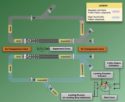
It’s been said for many years the private pilot certificate is a license to learn.
The underlying intent of the statement holds that with a private pilot certificate we have the freedom to get out and fly, to gain experience, and through that experience we might become better pilots.
That was the idea, anyway. In actual practice, not all experience leads to beneficial instruction.Consider this: Every time you fly, or cook dinner, or mow the lawn, you have an experience. Whether that experience is educational or not is something of a crap shoot. To a large extent, the determining factor has a lot to do with your attitude.

By Jonathan Thorne, Public Domain
It is possible to do the same thing over and over again without ever gleaning a single new insight from the process. Then again, it’s just as possible to discover something profound by simply thinking about the actions you might take, and recognizing nuances you’ve never noticed before.
Perhaps the most important thing for us to consider about learning is that it is not a one-way street. We can learn lessons that help us function better, or we can misinterpret our lessons and develop bad habits that lead us away from actual knowledge and toward simple belief.
Belief is bad. A dedication to belief in place of knowledge can put you in the hurt locker quick. And it might put some innocent in there with you.
Let me give you an example. While returning from a trip to south Florida recently, I called Miami Center to let them know my destination was in sight. I cancelled Flight Following, squawked 1200, and flipped over to the CTAF at my destination to listen for any traffic in the pattern.
There was only one aircraft up at that point. He was doing pattern work, and I heard him calling the same legs over and over as I approached. Each time around the pattern he called, Upwind, Crosswind, Downwind, Base, and Final.
Now I’m not going to quibble that Upwind is inaccurate on a takeoff. You’re really on the departure leg. Upwind suggests a go-around, when you’re flying in the direction of runway orientation, but off to the right side of the runway in order to keep a clear view of the traffic that might be coming up off the strip as you fly past. His call was technically incorrect, but it was understandable. There was a problem brewing though.
A low broken layer kept me from overflying the airport, so to get into a position where I could enter the pattern 45° to the downwind, I flew well to the east of the field, a good five miles from the departure end of the runway, headed north. That ultimately gave me a clear shot at turning into the airport, joining the pattern in the manner prescribed by the Aeronautical Information Manual, and making appropriate radio calls as I came in. All the while, the one airplane in the pattern continued to fly around the pattern.
What caught my ear most was the speed with which he transitioned from one leg to another. It was quick. Really quick. I assumed I was looking for a very powerful low wing, single-engine airplane that was moving at a high rate of speed. With eyes outside the cockpit 98% of the time, I prepared to enter the pattern.
I called that I was on a two-mile 45 to the downwind. He called downwind. I couldn’t see him and said so. I was concerned that I couldn’t pick this airplane out, so I began my turn to downwind a bit wider than I normally would, and called it on the CTAF. The other airplane called upwind.
That surprised me. He’d just called downwind 30 seconds earlier, now he was apparently going around. I called that I was looking for the traffic and established on downwind. He called that he was looking for me. I was approaching mid-field, on downwind, when I found him.

Diagram courtesy FAA
The other airplane was off my left wing, at perhaps 400 AGL, headed in my direction. His flight path was perpendicular to the runway, but well short of the departure end. Suddenly I knew how he was completing the pattern so quickly. He was turning crosswind as soon as he broke ground, turning downwind at half the altitude established for the pattern, and generally being where he wasn’t supposed to be for the entire circuit.
It was sad, but clear, from this experience that the other pilot had indeed been using his private pilot certificate as a license to learn, but he’d been learning all the wrong things. Rather than climb out on runway heading until he was 300 feet below pattern altitude and beyond the departure end of the runway as the AIM suggests, he simply turned crosswind at will.
This put him in the position to call downwind from not far beyond mid-field at an altitude well below that of the published traffic pattern. He was routinely putting himself in a position where no other pilot would be looking for him throughout his entire circuit of the pattern.
In essence, he had taught himself through experience to be unsafe, and to render the traffic pattern unsafe to others. That’s not what your CFI meant when (s)he said you had earned your license to learn. In fact, it’s the exact opposite of what they hoped you’d do with your ticket.
We all make mistakes. We all suffer from lapses of judgement. As human beings, that is unavoidable. But to learn, to truly learn we must start from a position that we all find uncomfortable; an acknowledgement of our own ignorance.
If we do that, we learn, we grow, and we become better more skillful people. If we don’t…well, as pilots it would be best if we avoid pioneering that region of the envelope.
Source: http://generalaviationnews.comAre you experienced?